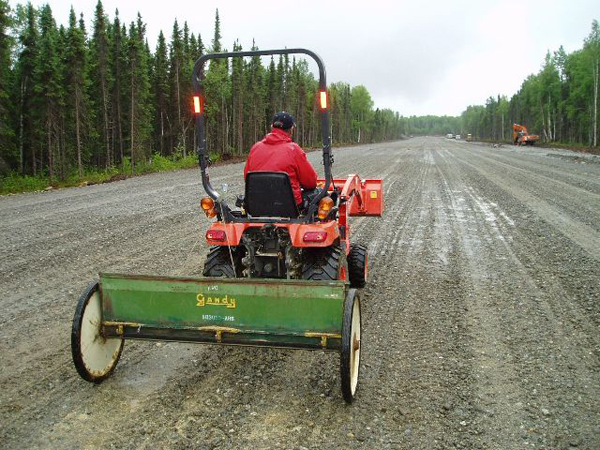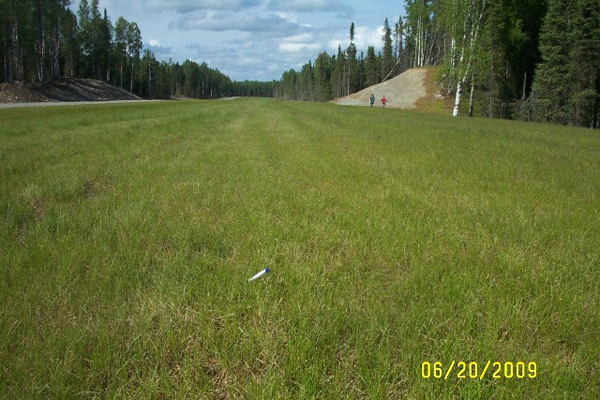 |
December 2012
|
December 2012 // Volume 50 // Number 6 // Ideas at Work // v50-6iw7
Improving Alaskan Aviation Safety with Turf Runways
Abstract
A leading cause of aviation accidents in Alaska is due to rock damage caused by taking off and landing on gravel runways. This article describes how Extension in Alaska planted a demonstration runway with an environmentally appropriate native grass to suppress rock damage to propellers, engines, control surfaces, and airframes. More than 200 runways have taken advantage of the program at an annual savings of 1.5 million dollars. The program has also resulted in national attention for the University of Alaska Fairbanks Mat-Su/Copper River Cooperative Extension Service District.
The State That Flies
Alaskans spend more time flying than any other group of Americans. This is due to the fact that most Alaskan communities are not connected by roadways. As a result, transportation between communities and the importation of goods are most often carried out by airplane. Medical emergencies occurring in small Alaskan villages commonly result in flights to regional medical centers. Also, many tourist activities center on flying. Backcountry hunters, fishers, adventurers, and even mountaineers all depend upon flights to and from their destinations.
Unfortunately, Alaska is also a state leader in the number of aviation accidents. The 5-year annual average of Alaskan flying accidents between 2005 and 2010 is 100.6 (FFA, 2010). The 5-year annual average of fatal accidents is 8.8. Because most of Alaska's runways are gravel (Flying in Alaska, 2011), many of these accidents result from rock impacts with propellers, jet engine turbofans, airframes, and flight control surfaces. Reducing the number of rock impacts could reduce the frequency of aviation accidents in Alaska. But how would one cheaply accomplish such a task?
A Chance Visit
In July of 2008, an airpark developer near Talkeetna, Alaska approached the Mat-Su/Copper River Cooperative Extension Service District office requesting technical assistance (an airpark is a residential community focused around an airstrip). He wanted to know how much topsoil would be needed to successfully grow Kentucky bluegrass on a 2,500 by 75 foot long runway. The developer reasoned that establishing a stand of turf on top of the gravel runway would greatly reduce rock damage. As a result, he could command a much higher price for lots in his airpark.
It was calculated that the developer would need a minimum of 187,000 square feet of topsoil exceeding $75,000 in cost. And this was contingent upon even being able to find that much topsoil to purchase in the first place. Despite these challenges, the developer was undaunted because of the economic advantages of marketing a reduced rock impact airpark. He quickly changed his mind, though, when asked if he would consider using a grass that didn't need topsoil (Figure 1.)
Figure 1.
Arctared Red Fescue Grass Growing in Gravel. Photo by Stephen C. Brown.

Conservation turf research at the University of Alaska Agricultural and Forestry Experiment Station and Alaska Plant Materials Center resulted in the development of two native Alaska red fescue (Arctared and Boreal) grasses appropriate for use in gravely soils (Hodgson, Taylor, Klebasadel, & Wilton, 1978; Wright, 2008).
Besides tolerating gravel conditions, red fescue was a much better choice than Kentucky bluegrass for several significant reasons. First, it is very cold tolerant, and the Arctared variety can even withstand winters above the Arctic Circle. Boreal red fescue is slightly cheaper, but not as cold tolerant and is recommended for areas south of the Alaska Range Mountains (Brown, 2011). Second, it has a low nutrient requirement and is drought tolerant. Third, red fescue is typically three to five times cheaper than Kentucky bluegrass. Finally, red fescue produces long rhizomes that anchor rocks and form sod much better than Kentucky bluegrass.
The Talkeetna Demonstration Runway
While growing red fescue on runways to prevent rock damage seemed like a good idea, it had never been documented in Alaska. After a literature review, only one aviation turf study was found, and that took place at airports in the Southeast United States (Tuccio, 2007). There was also no evidence of Extension turf outreach anywhere in the country specifically aimed at the aviation community.
The airpark developer who first approached Extension was asked if his runway could be developed and used as a demonstration runway. If he provided the seed and fertilizer, the Matanuska Experiment Farm would provide the equipment, and Extension would provide the technical expertise and labor. The developer agreed, and Alaska's first demonstration airstrip was underway in August of 2008 (Figures 2. and 3.).
Figure 2.
Planting the Talkeetna Demonstration Runway in August of 2008. Photo by Tim Evers.

Figure 3.
The Talkeetna Demonstration Runway Fully Grassed in June 2009. Photo by Jud Scott.

Giving Wings to the Word
Starting in August of 2009 a series of 2-hour workshops titled "Establishing and Managing Grass Airstrips in Alaska" were conducted for airport owners or managers. Workshops were conducted at or near regional airports. The workshops were usually held in hangers or designated meeting places at the airport. If the workshop could not be conducted at the airport, transportation was provided to the meeting location. As part of the workshop, pilots were given Global Positioning System coordinates to the Talkeetna Demonstration Runway so that they could make an aerial visit on their own.
Extension worked very closely with the Federal Aviation Administration (FAA) in Alaska on advertising and implementing these programs. The FAA in Alaska would go on to cite its partnership with Extension as integral to its accident prevention program in the state.
Articles were written for aviation club newsletters such as the Alaska Airmen's Association (Brown, 2010) and for various newspapers around the state. The Associated Press picked up the story, and articles appeared in newspapers and magazines around the nation.
The Result
More than 200 runways in Alaska have been planted or are scheduled to be planted with red fescue grass to reduce rock damage. The Alaska Department of Transportation operates many gravel runways in Alaska and is considering grassing their runways as a cheaper alternative to asphalt and concrete.
A single pebble can destroy a jet engine, and even the minor resurfacing of a jet turbofan can exceed $100,000. For small planes a single rock impact can destroy a propeller costing $7,000 and frequently much more. Small rock-caused tears to covering fabrics can lead to hidden structural and component corrosion. The resulting repairs can be extremely expensive because the damage takes place over a long period of time in unseen areas. This is especially true for coastal airports exposed to salt spray.
While it is difficult to know what the eventual economic impact will be, it is conservatively estimated to be 1.5 million dollars annually. Of greater importance is the potential reduction in aviation accidents. An analysis of the 5-year aviation accident average for 2010-2015 should be promising.
Extension Implications Beyond Alaska
The aviation community has never been a traditional audience for Extension. However, this project opened new partnerships that greatly enhanced Extension's influence and impact in Alaska. The same could very likely be true in other states. This project received a great deal of national publicity through website, newspaper, and magazine articles. As a result, many dozens of inquiries beyond Alaska were received requesting more information. One inquiry was even received from the Pentagon, pursuing how this project could be used on runways in Afghanistan.
In most cases, the information being sought was fundamental horticultural knowledge that most county Extension programs could easily provide. Using information in this article, an Extension professional need not have any aviation background to provide important and much-needed outreach to the flying community. According to Tuccio (2007), grass runway construction and maintenance has become a lost art since World War II. Perhaps Extension can provide a runway renaissance.
References
Brown, S. C. (2011). Planting grass on gravel runways in Alaska (HGA-00340). University of Alaska Fairbanks Cooperative Extension Service, Retrieved from: http://www.uaf.edu/files/ces/publications-db/catalog/anr/HGA-00340.pdf
Brown, S. C. (2010). Grassing your gravel airstrip. The Transponder, Alaska Airmen's Association, April/May.
Flying in Alaska. (2011). Alaska State Department of Transportation. Retrieved from: http://www.dot.state.ak.us/stwdav/akfly.shtml
FAA. (2010). Alaska flight statistics FY April 2010. Federal Aeronautical Administration. Retrieved from: http://www.faa.gov/about/office_org/headquarters_offices/avs/offices/afs/divisions/alaskan_region/acc_stats/
media/2010/Alaska_Accident_StatisticsFY10APR.pdf
Hodgson, H. J., Taylor, R. L., Klebasadel, L. J., & Wilton, A. C. (1978). Registration of Arctared red fescue. Crop Science, Vol. 18, May-June.
Tuccio, W. A. (2007). A comparison of turf management practices at turf runway airports in the southeast. Embry-Riddle Aeronautical University Worldwide, Fort Walton Beach Campus.
Wright, S. J. (2008). A revegetation manual for Alaska. Division of Agriculture, Alaska Department of Natural Resources.




